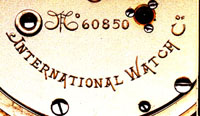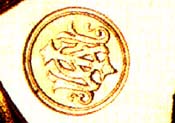
Home to Robert's site
|
Home to Robert's site |
|
|
Marks on the Movement
 We came to another conclusion: that the founder of the company,
Florentine A. Jones immortalized members of his family and American heroes on the
movementsplate. Toelke/King give some more details on that in their book about IWC
Schaffhausen on page 34.The company name can be found (English italics) on all calibers by
Jones (with movement numbers 1 to around 26,000), the Seeland-caliber (circa
26,000-61,000), caliber 28/29 a bascule pilier (100,000 to 120,000) as well as the early
calibers 32, 33, 34, 35, 59 and 60 with very low movement numbers like 33, 86 616 or
something like 620.In the course of 1884, IWC switched to a complete new numbering and
marking. The oldest mark is a flat "I" with the capitals "WC". This
was used only on the movements of the digital watches Pallweber I and Pallweber II during
1884 and 1885 (movement numbers 1000 to 6500).With the digital watches Pallweber III a new
variety of markings is introduced. We came to another conclusion: that the founder of the company,
Florentine A. Jones immortalized members of his family and American heroes on the
movementsplate. Toelke/King give some more details on that in their book about IWC
Schaffhausen on page 34.The company name can be found (English italics) on all calibers by
Jones (with movement numbers 1 to around 26,000), the Seeland-caliber (circa
26,000-61,000), caliber 28/29 a bascule pilier (100,000 to 120,000) as well as the early
calibers 32, 33, 34, 35, 59 and 60 with very low movement numbers like 33, 86 616 or
something like 620.In the course of 1884, IWC switched to a complete new numbering and
marking. The oldest mark is a flat "I" with the capitals "WC". This
was used only on the movements of the digital watches Pallweber I and Pallweber II during
1884 and 1885 (movement numbers 1000 to 6500).With the digital watches Pallweber III a new
variety of markings is introduced. In total, three different round markings can be found. These
were used from 1885 till 1890 for the movements 6501 to 62,900. In total, three different round markings can be found. These
were used from 1885 till 1890 for the movements 6501 to 62,900.
The next mark in line is the Schaffhauser Bock, or the
Billy-goat of Schaffhausen. This was used from 1891 till 1895 (movement numbers 63,000 to
102,000), and was replaced by the "JWC" marking in the famous lens. This
signature was used from 1895 till 1905 (numbers 102,000 to 350,000).Somewhere onward from
movement number 350,000, the most famous marking was introduced: the "Probus
Scafusia", which today still marks the authenticity of the IWC caliber. This article is translated from the article "Punze am Werk", by Werner Berghaus, published in Watch International, nr.4 / 1998 (p. 58-60) |